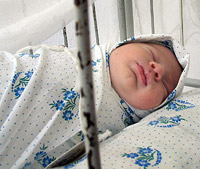It’s not common to see a massive emigration from Artashat city of the Ararat region of Armenia because the people there grow and sell their crops in the summer, collect wood and eat dried fruit during the winter.
The “August-23” street of Artashat is littered and it has been two years since the public café closed down. It was purchased by a sect and the entire property is locked up. The two women standing by the bus stop were complaining that things were better back in the days of the Soviet Union; there were parks, a lake. The lake has dried up and the streets are littered, but the mayor doesn’t seem to care.
“An intelligent person can’t live in Artashat,” said one teacher.
In general, the people of Artashat are careful when making comments. Even the old woman selling vegetables near the maternity ward secretly said that giving birth is free in Artashat. According to her, the state grants 30,000 AMD for the birth of children. She means the 33,000 social payments for women giving birth.
The polyclinic, the municipal hospital and the maternity ward are all next to each other in Artashat. The average number of children born in Artashat yearly is 700 compared to the 1500. Director of the Artashat maternity ward Mrs. Zemphira Navasardyan says that during the past couple of years, there are younger women giving birth. Girls between the ages of 15-18 are giving birth to children with “an immature brain and an immature body”, as she says. They give birth to the third, fourth, fifth, even the sixth child.
“We have good funding. You may be scared after seeing the first floor of the building, but that has to do with the nearby lake because there is no hydraulics there. But the second floor is in good condition and we even have Euro-remodeled rooms,” said the director.
There were only bathrooms and refrigerators in the Euro-remodeled rooms, which the director likes to call “VIP”. Mrs. Navasardyan says that the mother must pay 10,000 AMD to stay in the room for three days. The women in the rooms were scared to talk about that. You got the impression that they had been told beforehand not to speak to journalists. After taking surveys from mothers, I found out that giving birth is free in that part of the city and doctors are generous because their average salary is 50,000 AMD.
“The nurses take good care of the newborns by giving them new sheets and changing them quickly,” says 21-year old Anahit. For a moment I thought that Artashat was living in the days of communism and it was possible to give birth at this maternity ward without worrying about extra expenses. The equipment is old, but there is no need to complain because the doctors are able to provide medical aid.
Compared to other departments, the one with the most patients was the Women Consultation department, where gynecologist/pediatrician A. Ghazaryan mainly consults with women who would like to use birth control pills.
Birth control pills have been around in Armenia for the past 10 years. The doctor/specialist, who wished to remain anonymous, joked that international organizations send so many birth control pills to Armenia that they are enough for the whole family. He says that those pills, which damage the neuron-hormonal system, haven’t been used by developed countries for a while now, but they continue to cause problems for Armenians.
The Artashat municipal hospital was equipped with diagnostic, medical as well as first aid services. The director of the ward said that their three cars are enough for them and the equipment. He says that not many youth go to the capital city; there is only a need for operating doctors and first aid. An average of 2500 people are treated at the Artashat municipal hospital yearly and there are 600-650 operations a year and 450 ambulance calls. Director of the Artashat hospital joint-stock company Avik Petrosyan thanked the Central Bank of Armenia for the optimization program, which will join the polyclinic, the maternity ward, the anti-tuberculosis dispensaries and the hospital together.
“That way, we will have fewer expenses and will use the saved money for other expenses,” says A. Petrosyan. As for the unemployment due to the optimization program, Petrosyan pointed out that there will be new work places. Perhaps the people will work as clerks/waiters because the high number of workers diminished from 400 to 100. Despite that, the director of the hospital assured that the residents of Artashat don’t go to the city hospital.

